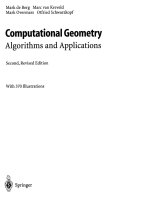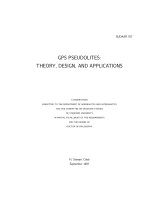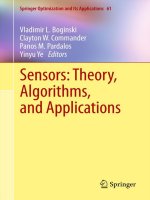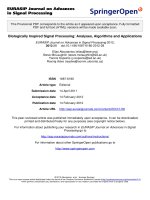sensors theory, algorithms, and applications
Bạn đang xem bản rút gọn của tài liệu. Xem và tải ngay bản đầy đủ của tài liệu tại đây (6.78 MB, 253 trang )
Springer Optimization and Its Applications
VOLUME 61
Managing Editor
Panos M. Pardalos (University of Florida)
Editor–Combinatorial Optimization
Ding-Zhu Du (University of Texas at Dallas)
Advisory Board
J. Birge (University of Chicago)
C.A. Floudas (Princeton University)
F. Giannessi (University of Pisa)
H.D. Sherali (Virginia Polytechnic and State University)
T. Terlaky (McMaster University)
Y. Ye (Stanford University)
Aims and Scope
Optimization has been expanding in all directions at an astonishing rate
during the last few decades. New algorithmic and theoretical techniques
have been developed, the diffusion into other disciplines has proceeded at a
rapid pace,and our knowledge of all aspects of the field has grown even more
profound. At the same time, one of the most striking trends in optimization
is the constantly increasing emphasis on the interdisciplinary nature of the
field. Optimization has been a basic tool in all areas of applied mathematics,
engineering, medicine, economics, and other sciences.
The series Springer Optimization and Its Applications publishes under-
graduate and graduate textbooks, monographs and state-of-the-art exposi-
tory work that focus on algorithms for solving optimization problems and
also study applications involving such problems. Some of the topics covered
include nonlinear optimization (convex and nonconvex), network flow
problems, stochastic optimization, optimal control, discrete optimization,
multi-objective programming, description of software packages, approxima-
tion techniques and heuristic approaches.
For further volumes:
/>
Vladimir L. Boginski • Clayton W. Commander
Panos M. Pardalos • Yinyu Ye
Editors
Sensors: Theory, Algorithms,
and Applications
123
Editors
Vladimir L. Boginski
Department of Industrial and Systems
Engineering
University of Florida
303 Weil Hall
Gainesville, FL 32611
USA
fl.edu
Panos M. Pardalos
Department of Industrial and Systems
Engineering
University of Florida
303 Weil Hall
Gainesville, FL 32611
USA
pardalos@ufl.edu
Clayton W. Commander
Air Force Research Laboratory
Munitions Directorate
Eglin Air Force Base
101 West Eglin Boulevard
Eglin AFB, FL 32542
USA
Yinyu Ye
Department of Management Science
and Engineering
Huang Engineering Center 308
School of Engineering
Stanford University
475 Via Ortega
Stanford, CA 94305
USA
ISSN 1931-6828
ISBN 978-0-387-88618-3 e-ISBN 978-0-387-88619-0
DOI 10.1007/978-0-387-88619-0
Springer New York Dordrecht Heidelberg London
Library of Congress Control Number: 2011941384
© Springer Science+Business Media, LLC 2012
All rights reserved. This work may not be translated or copied in whole or in part without the written
permission of the publisher (Springer Science+Business Media, LLC, 233 Spring Street, New York,
NY 10013, USA), except for brief excerpts in connection with reviews or scholarly analysis. Use in
connection with any form of information storage and retrieval, electronic adaptation, computer software,
or by similar or dissimilar methodology now known or hereafter developed is forbidden.
The use in this publication of trade names, trademarks, service marks, and similar terms, even if they are
not identified as such, is not to be taken as an expression of opinion as to whether or not they are subject
to proprietary rights.
Printed on acid-free paper
Springer is part of Springer Science+Business Media (www.springer.com)
Preface
In recent years, technological advances have resulted in the rapid development of
a new exciting research direction – the interdisciplinary use of sensors for data
collection, systems analysis, and monitoring. Application areas include military
surveillance, environmental screening, computational neuroscience, seismic detec-
tion, transportation, along with many other important fields.
Broadly speaking, a sensor is a device that responds to a physical stimulus (e.g.,
heat, light, sound, pressure, magnetism, or motion) and collects and measures data
regarding some property of a phenomenon, object, or material. Typical types of
sensors include cameras, scanners, radiometers, radio frequency receivers, radars,
sonars, thermal devices, etc.
The amount of data collected by sensors is enormous; moreover, this data is
heterogeneous by nature. The fundamental problems of utilizing the collected data
for efficient system operation and decision making encompass multiple research
areas, including applied mathematics, optimization, and signal/image processing, to
name a few. Therefore, the task of crucial importance is not only developing the
knowledge in each particular research field, but also bringing together the expertise
from many diverse areas in order to unify the process of collecting, processing,
and analyzing sensor data. This process includes theoretical, algorithmic, and
application-related aspects, all of which constitute essential steps in advancing the
interdisciplinary knowledge in this area.
Besides individual sensors, interconnected systems of sensors, referred to as
sensor networks, are receiving increased attention nowadays. The importance of
rigorous studies of sensor networks stems from the fact that these systems of
multiple sensors not only acquire individual (possibly complimentary) pieces
of information, but also effectively exchange the obtained information. Sensor
networks may operate in static (the locations of individual sensor nodes are fixed)
or dynamic (sensor nodes may be mobile) settings.
Due to the increasing significance of sensor networks in a variety of applications,
a substantial part of this volume is devoted to theoretical and algorithmic aspects of
problems arising in this area. In particular, the problems of information fusion are
especially important in this context, for instance, in the situations when the data
v
vi Preface
collected from multiple sensors is synthesized in order to ensure effective operation
of the underlying systems (i.e., transportation, navigation systems, etc.). On the
other hand, the reliability and efficiency of the sensor network itself (i.e., the ability
of the network to withstand possible failures of nodes, optimal design of the network
in terms of node placement, as well as the ability of sensor nodes to obtain location
coordinates based on their relative locations – known as sensor network localization
problems) constitutes another broad class of problems related to sensor networks.
In recent years, these problems have been addressed from rigorous mathematical
modeling and optimization perspective, and several chapters in this volume present
new results in these areas.
From another theoretical viewpoint, an interesting related research direction
deals with investigating information patterns (possibly limited or incomplete)
that are obtained by sensor measurements. Rigorous mathematical approaches
that encompass dynamical systems, control theory, game theory, and statistical
techniques, have been proposed in this diverse field.
Finally, in addition to theoretical and algorithmic aspects, application-specific
approaches are also of substantial importance in many areas. Although it is
impossible to cover all sensor-related applications in one volume, we have included
the chapters describing a few interesting application areas, such as navigation
systems, transportation systems, and medicine.
This volume contains a collection of chapters that present recent developments
and trends in the aforementioned areas. Although the list of topics is clearly not
intended to be exhaustive, we attempted to compile contributions from different
research fields, such as mathematics, electrical engineering, computer science, and
operations research/optimization. We believe that the book will be of interest to
both theoreticians and practitioners working in the fields related to sensor networks,
mathematical modeling/optimization, and information theory; moreover, it can also
be helpful to graduate students majoring in engineering and/or mathematics, who
are looking for new research directions.
We would like to take the opportunity to thank the authors of the chapters for their
valuable contributions, as well as Springer staff for their assistance in producing this
book.
Gainesville, FL, USA Vladimir L. Boginski
Clayton W. Commander
Panos M. Pardalos
Yinyu Ye
Contents
Part I Models and Algorithms for Ensuring Efficient
Performance of Sensor Networks
On Enhancing Fault Tolerance of Virtual Backbone
in a Wireless Sensor Network with Unidirectional Links 3
RaviTiwariandMyT.Thai
Constrained Node Placement and Assignment in Mobile
Backbone Networks 19
Emily M. Craparo
Canonical Dual Solutions to Sum of Fourth-Order Polynomials
Minimization Problems with Applications to Sensor
Network Localization 37
David Yang Gao, Ning Ruan, and Panos M. Pardalos
Part II Theoretical Aspects of Analyzing
Information Patterns
Optimal Estimation of Multidimensional Data with Limited
Measurements 57
William MacKunis, J. Willard Curtis, and Pia E.K. Berg-Yuen
Information Patterns in Discrete-Time Linear-Quadratic
Dynamic Games 83
Meir Pachter and Khanh D. Pham
The Design of Dynamical Inquiring Systems: A Certainty
Equivalent Formalization 119
Laura Di Giacomo and Giacomo Patrizi
vii
viii Contents
Part III Sensors in Real-World Applications
Sensors in Transportation and Logistics Networks 145
Chrysafis Vogiatzis
Study of Mobile Mixed Sensing Networks in an Automotive Context 165
Animesh Chakravarthy, Kyungyeol Song, Jaime Peraire,
and Eric Feron
Navigation in Difficult Environments: Multi-Sensor Fusion Techniques 199
Andrey Soloviev and Mikel M. Miller
A Spectral Clustering Approach for Modeling Connectivity
Patterns in Electroencephalogram Sensor Networks 231
Petros Xanthopoulos, Ashwin Arulselvan, and Panos M. Pardalos
Contributors
Ashwin Arulselvan Technische Universit
¨
at Berlin, Berlin, Germany,
Pia E.K. Berg-Yuen Air Force Research Laboratory Munitions Directorate, Eglin
AFB, FL 32542, USA,
Animesh Chakravarthy Wichita State University, Wichita, KS, USA,
Emily M. Craparo Naval Postgraduate School, Monterey, CA, USA,
J. Willard Curtis Air Force Research Laboratory Munitions Directorate, Eglin
AFB, FL 32542, USA,
Laura Di Giacomo Dipartimento di Statistica, Sapienza Universita’ di Roma, Italy
Eric Feron Georgia Tech Atlanta, GA, USA,
David Yang Gao University of Ballarat, Mt. Helen, VIC 3350, Australia,
William MacKunis Air Force Research Laboratory Munitions Directorate, Eglin
AFB, FL 32542, USA,
Mikel M. Miller Air Force Research Laboratory Munitions Directorate, Eglin
AFB, FL 32542, USA,
Meir Pachter Air Force Institute of Technology, Wright-Patterson AFB, OH 45433,
USA, meir.pachter@afit.edu
Panos M. Pardalos University of Florida, Gainesville, FL 32611, USA,
pardalos@ufl.edu
Giacomo Patrizi Dipartimento di Statistica, Sapienza Universita’ di Roma, Italy,
ix
x Contributors
Jaime Peraire Massachusetts Institute of Technology, Cambridge, MA, USA,
Khanh D. Pham Air Force Research Laboratory, Space Vehicles Directorate,
Kirtland AFB, NM 87117, USA,
Ning Ruan Curtin University of Technology, Perth, WA 6845, Australia,
Andrey Soloviev Research and Engineering Education Facility, University of
Florida, Shalimar, FL 32579, USA, soloviev@ufl.edu
Kyungyeol Song McKinsey Corporation Seoul, South Korea,
My T. Thai University of Florida, Gainesville, FL 32611, USA,
fl.edu
Ravi Tiwari University of Florida, Gainesville, FL 32611, USA,
fl.edu
Chrysafis Vogiatzis University of Florida, Gainesville, FL 32611, USA,
chvogiat@ufl.edu
Petros Xanthopoulos University of Florida, Gainesville, FL 32611, USA,
petrosx@ufl.edu
Part I
Models and Algorithms for Ensuring
Efficient Performance of Sensor Networks
On Enhancing Fault Tolerance of Virtual
Backbone in a Wireless Sensor Network
with Unidirectional Links
Ravi Tiwari and My T. Thai
Abstract A wireless sensor network (WSN) is a collection of energy constrained
sensor node forming a network which lacks infrastructure or any kind of centralized
management. In such networks, virtual backbone has been proposed as the routing
infrastructure which can alleviate the broadcasting storm problem occurring due
to consistent flooding performed by the sensor node, to communicate their sensed
information. As the virtual backbone nodes needs to carry other nodes’ traffic,
they are more subject to failure. Hence, it is desirable to construct a fault tolerant
virtual backbone. Most of recent research has studied this problem in homogeneous
networks. In this chapter, we propose solutions for efficient construction of a
fault tolerant virtual backbone in a WSN where the sensor nodes have different
transmission ranges. Such a network can be modeled as a disk graph (DG), where
link between the two nodes is either unidirectionalor bidirectional.We formulate the
fault tolerant virtual backbone problem as a k-Strongly Connected m-Dominating
and Absorbing Set .k; m/ SCDAS problem. As the problem is NP-hard, we propose
an approximation algorithm along with the theoretical analysis and conjectured its
approximation ratio.
1 Introduction
A wireless sensor network (WSN) is a collection of power constrained sensors
nodes with a base station. The sensors are supposed to sense some phenomena
and collect information, which is required to be sent to the base station for further
forwarding or processing. As the sensors are power constraint, their transmission
R. Tiwari • M.T. Thai ()
Computer Science and Engineering Department, University of Florida, Gainesville, FL, USA
e-mail: fl.edu; fl.edu
V.L. Boginski et al. (eds.), Sensors: Theory, Algorithms, and Applications,
Springer Optimization and Its Applications 61, DOI 10.1007/978-0-387-88619-0
1,
© Springer Science+Business Media, LLC 2012
3
4 R. Tiwari and M.T. Thai
ranges are small. Hence, the sensed information may be relayed on multiple
intermediate sensor nodes before reaching the base station. As there is no fixed
or predefined infrastructure, in order to enable data transfer in such networks, all the
sensor nodes frequently flood control messages, thus causing a lot of redundancy,
contentions, and collisions [20]. As a result, a virtual backbone has been proposed
as the routing infrastructure of such networks for designing efficient protocols for
routing, broadcasting, and collision avoidance [1]. With virtual backbone, routing
messages are only exchanged between the sensor nodes in the virtual backbone,
instead of being flooded to all the sensor nodes. With the help of virtual backbone,
routing is easier and can adapt quickly to network topology changes. It has been
seen that the virtual backbones could dramatically reduce routing overhead [18].
Furthermore, using virtual backbone as relay nodes can efficiently reduce the energy
consumption, which is one of the critical issues in WSNs to maximize the sensor
network lifetime.
However, transmission range of all the sensor nodes in the WSN are not
necessarily equal. As the transmission range depends upon the energy level of
a sensor node which can be different for different sensor nodes, this may result
in sensor nodes having different transmission range. The sensor nodes can also
tune their transmission ranges depending upon their functionality, or they may
perform some power control to alleviate collisions or to achieve some level of
connectivity. In some topology controlled sensor networks, sensor nodes may adjust
their transmission ranges differently to obtain certain optimization goals. All these
scenarios result into the WSN with different transmission ranges. Such a network
can be modeled as a Disk Graph (DG) G. Note that G is a directed graph, consisting
both bidirectional and unidirectional links.
Since the virtual backbone nodes in the WSN need to relay other sensor node’s
traffic, so, due to heavy load often they are vulnerable to frequent nodeor link failure
which is inherent in WSNs. Hence, it is very important to study the fault tolerance
of the virtual backbone in wireless sensor networks. Therefore, constructing a fault
tolerant virtual backbone that continues to function during node or link failure is
an important research problem, which has been not studied sufficiently. In [6, 7],
the authors considered this problem in Unit Disk Graph (UDG) [2], in which all
nodes have the same transmission ranges. When a wireless network has nodes with
same transmission ranges then it will only have bidirectional links. In such a case
the virtual backbone is represented by the connected dominating set (CDS) of the
graph representing the wireless network. Whereas, when the wireless network has
nodes with different transmission range then it will have both unidirectional and
bidirectional links. In this case the virtual backbone is represented by a strongly
connected dominating and absorbing set (SCDAS) [12], here, a node not in virtual
backbone has at least one virtual backbone node as its incoming and outgoing
neighbor, respectively.
Although the virtual backbone problem has been extensively studied in general
undirected graphs and UDGs [3, 13, 16, 17, 19, 21–23], the construction of virtual
backbone in wireless networks with different transmission ranges is explored to a
On Enhancing Fault Tolerance of Virtual Backbone 5
little extent. In [8]and[5], the authors extended their marking process to networks
with unidirectional links to find a SCDAS. However, the paper does not present any
approximation ratio. Recently, we proposed a constant approximation algorithms for
SCDAS problem [4, 10,12, 14]. The construction of fault tolerant virtual backbone
in general undirected graphs is also one of the newly studied problems. Dai et al.
addressed the problem of constructing k-connected k dominating set (.k; k/ CDS)
[6] in UDG. In Feng et al. [7] introduced the problem of constructing .2; 1/ CDS
in UDGs and proposed a constant approximation ratio. Note that the solutions of
these two papers are applicable only to undirected graphs. In addition, the authors
just considered a special case of the general problem, where k D m or k D 2 and
m D 1.In[24] Wu et al. studied the construction of .k; m/ CDS but they considered
undirected graph. Recently, we have considered the fault tolerant virtual backbone in
heterogeneous networks with only bidirectional links [15]. We proposed a constant
approximation algorithm for any value of k and m. In summary, no work has studied
the .k; m/ SCDAS in heterogeneous networks with unidirectional and bidirectional
links for any value of k and m.
In this chapter we study the enhancing of fault tolerance of virtual backbone
in WSN represented by a directed disk graph(DG). The virtual backbone in this
case is represented as a strongly connected dominating and absorbing set (SCDAS).
The fault tolerance of a virtual backbone can be enhanced in two aspects. Firstly,
by increasing the dominance and absorption of the virtual backbone nodes, i.e.,
by increasing the number of virtual backbone nodes in the incoming and outgoing
neighborhood of a non-virtual backbone nodes. Secondly, by increasing the con-
nectivity of the virtual backbone, by ensuring the nodes in virtual backbone has
multiple paths to each other in the subgraph induced by them. In order to generate
a fault tolerant virtual backbone, we formulate the .k; m/ SCDAS problem. The
.k; m/ SCDAS problem is to find an SCDAS of a directed graph G D .V; E/ such
that the graph induced by the .k; m/ SCDAS nodes is k-strongly node connected and
any node not in .k; m/ SCDAS has at least m nodes in its incoming and outgoing
neighborhood, respectively.
The rest of this chapter is organized as follows. Section 2 describes the
preliminaries, network model, and problem definition. The enhancement of fault
tolerance of virtual backbone in terms of dominance and absorption is studied in
Sect. 3. In Sect. 4 w
e conclude the chapter with a brief summary.
2 Network Model and Problem Definition
2.1 Preliminaries
Let a directed graph G D .V; E/ represent a network where V consists of all nodes
in a network and E represents all the communication links.
6 R. Tiwari and M.T. Thai
For any vertex v 2 V ,theincoming neighborhood of v is defined as N
.v/ D
fu 2 V j .u; v/ 2 Eg,andtheoutgoing neighborhood of v is defined as N
C
.v/ D
fu 2 V j .v; u/ 2 Eg.
Likewise, for any vertex v 2 V ,theclosed incoming neighborhood of v is
defined as N
Œv D N
.v/ [fvg,andtheclosed outgoing neighborhood of v is
defined as N
C
Œv D N
C
.v/ [fvg.
A subset S Â V is called a dominating set (DS) of G iff S [N
C
.S/ D V where
N
C
.S/ D
S
u2S
N
C
.u/ and 8v 2 N
C
.S/; N
.v/ \ S ¤;.IfjN
.v/ \ Sjm,
then S is said to be a m dominating set.
A subset A Â V is called an absorbing set (AS) of G iff A[N
.S/ D V where
N
.S/ D
S
u2S
N
.u/ and 8v 2 N
.S/; N
C
.v/ \ S ¤;.IfjN
C
.v/ \ Sjm,
then A is said to be a m absorbing set.
A subset S Â V is called an independent set (IS) of G iff S [N
C
.S/ D V and
S \ N
C
.S/ D;.
A subset SI Â V is called a Semi-independent Set (SI) of G iff u; v 2 SI, then,
f.u; v/; .v; u/g…E,orif.u; v/ 2 E then .v; u/ … E and vice-versa. Nodes u and v
are said to be Semi-independent to each other.
Given a subset S Â V ,aninduced subgraph of S , denoted as GŒS, obtained
by deleting all vertices in the set V S from G.
A directed graph G is said to be strongly connected if for every pair of nodes
u; v 2 V , there exists a directed node disjoint path. Likewise, a subset S Â V is
called a strongly connected set if GŒS is strongly connected. If for every pair of
nodes u; v 2 V , there exists at least k directed node disjoint paths then the graph G
is said to be k strongly connected, similarly a subset S Â V is
called a k str
ongly
connected set if GŒS is k strongly connected.
A subset S Â V is called a Strongly Connected Dominating Set (SCDS)
if S is a DS and GŒS is strongly connected. S is called a Strongly Connected
Dominating and Absorbing Set (SCDAS) if S is an SCDS and for all nodes u … S,
N
C
.u/ \ S ¤;and N
.u/ \ S ¤;. S is a .k; m/ SCDAS if it is k strongly
connected and m dominating and m absorbing.
2.2 Network Model and Problem Definition
In this chapter, we study the fault tolerant virtual backbone in wireless sensor
networks with different transmission ranges. In this case, the WSN can be modeled
as a directed graph G D .V; E/. The sensor nodes in V are located in the two
dimensional Euclidean plane and each sensor node v
i
2 V has a transmission range
r
i
2 Œr
min
;r
max
. A directed edge .v
i
; v
j
/ 2 E if and only if d.v
i
; v
j
/ Ä r
i
,where
d.v
i
; v
j
/ denotes the Euclidean distance between v
i
and v
j
. Such a directed graphs
G is called Disk Graphs (DG). An edge .v
i
; v
j
/ is bidirectional if both .v
i
; v
j
/ and
.v
j
; v
i
/ are in E, i.e., d.v
i
; v
j
/ Ä minfr
i
;r
j
g. Otherwise, it is a unidirectional edge.
Figure 1 shows a disk graph (DG), here the black dots represents the sensor nodes
and the dotted circles around them represents their transmission disks. The directed
On Enhancing Fault Tolerance of Virtual Backbone 7
Fig. 1 A disk graph (DG)
with unidirectional and
bidirectional links
arrows represent the unidirectional links whereas the bidirected edge represents
bidirectional links. In our network model, we consider both unidirectional and
bidirectional edges.
The virtual backbone in a WSN that can be represented by the connected
dominating set (CDS). In this chapter we studied the fault tolerance of the virtual
backbone in the WSN modeled as a disk graph (DG). In this case the virtual
backbone can be represented by a strongly connected dominating and absorbing
set (SCDAS). There can be two kinds of faults occurring in WSN. A sensor node
can become faulty or a link between two sensor nodes might go down. Hence, the
fault tolerance of virtual backbone in WSN can be enhanced in two ways. Firstly, by
enhancing the dominance and the absorption of the SCDAS representing the virtual
backbone by ensuring more SCDAS nodes are there as incoming and outgoing
neighbors to a non-SCDAS node. This ensures that a non-virtual backbone node
has other options to forward its data, if one of its virtual backbone neighbor goes
down due to some failure. Secondly, by ensuring there are multiple paths between
the virtual backbone nodes in the subgraph generated by the virtual backbone nodes,
so that if a link between two virtual backbone goes down it would not affect
the connectivity of the virtual backbone. This can be achieved by increasing the
connectivity of the SCDAS representing the virtual backbone.
Under such a model and requirements, we formulate the fault tolerant virtual
backbone problem as follows:
k-Strongly Connected m Dominating and Absorbing Set problem (.k; m/
SCDAS): Given a directed graph G D .V; E/ representing a sensor network and
8 R. Tiwari and M.T. Thai
two positive integers k and m, find a subset C Â V with a minimum size and
satisfying the following conditions:
• C is an SCDAS
• The subgraph G.C/ is k-connected
• Each node not in C is dominated and absorbed by at least m nodes in C
3 Enhancing Domination and Absorption
of the Virtual Backbone
In this section we study enhancing fault tolerance of the virtual backbone in the
WSN represented by a directed disk graph G D .V; E/. The fault tolerance of a
virtual backbone needs to be enhanced in two aspects, firstly in terms of domination
and absorbtion, secondly, in terms of connectivity of the subgraph induced by the
virtual backbone nodes. As a fault tolerant virtual backbone in the WSN with
unidirectional and bidirectional links can be represented by a .k; m/ SCDAS, hence,
we propose an approximation algorithm for constructing a .k; m/ SCDAS for a
directed disk graph G D .V; E/ representing the WSN for any value of k and
m. We also provide the theoretical analysis of our algorithm and conjectured its
approximation ratio. The .k; m/ SCDAS of graph G represents the virtual backbone
of the WSN such that any node v not in virtual backbone has at least m virtual
backbone nodes in N
C
.v/ and N
.v/, respectively, and the graph induced by
the virtual backbone nodes is k-strongly connected. This ensures that the virtual
backbone can sustain m 1 virtual backbone nodes failure without isolating any
non-virtual backbone node from the virtual backbone and it can sustain k 1 virtual
backbone nodes failure without disconnecting the virtual backbone. In order to
generate a .k; m/ SCDAS we first generate an .1; m/ SCDAS, which is a special case
of .k; m/ SCDAS where k D 1. We then enhance the connectivity of the subgraph
induced by the .1; m/ SCDAS nodes to make it k-node connected, which results in
a .k; m/ SCDAS.
3.1 An Approximation Algorithm for .k; m/ SCDAS Problem
The algorithm for generating the .k; m/ SCDAS is illustrated in Algorithm 1.In
order to generate a .k; m/ SCDAS we first generate a .1; m/ SCDAS, which is
a special case of .k; m/ SCDAS where k D1. The algorithm for generating a
.1; m/ SCDAS is illustrated in Algorithm 2.
The construction of .1; m/ SCDAS is divided into two phases. In the first phase
a strongly connected dominating and absorbing set (SCDAS) is generated and then
in the second phase extra nodes are iteratively added to make it m dominating. In
the first phase a strongly connected dominating and absorbing set is generated by
On Enhancing Fault Tolerance of Virtual Backbone 9
Algorithm 1 Approximation Algorithm for .k; m/-Strongly Connected Dominating
and Absorbing Set
1: INPUT: An m-connected directed graph G D .V; E/,herem k
2: OUTPUT: A .k; m/ SCDAS C of G
3: Run Algorithm 2 on G to generated an .1; m/ SCDAS C .
4: for Every pair of black nodes v
i
; v
j
2 C do
5: C D C[FindkPath.G;i;j;k/
6: end for
7: Return C as the k-m-SCDAS
Algorithm 2 Algorithm for .1; m/ Strongly Connected Dominating and Absorbing
Set
1: INPUT: An m connected directed graph G D .V; E/
2: OUTPUT: A .1; m/ SCDAS C of G
3: Generate a directed graph G
0
by reversing the edges of graph G
4: Select a nodes s as a root.
5: C D;
6: C D C [Find DS1 (G,s);
7: C D C [Find DS1 (G
0
,s);
8: for i D 1Ii Ä m 1Ii CCdo
9: Color all the Gray nodes in G and G
0
White
10: C D C [Find DS2 (G)
11: C D C [Find DS2 (G
0
)
12: end for
13: The set C is the .1; m/ SCDAS
calling Algorithm 3 twice. When Algorithm 3 terminates there are three different
color nodes in the graph; the black nodes, the blue nodes, and the gray nodes. In
first call to Algorithm 3 the graph G and a node s are passed as the parameter and
it returns a set of black and blue nodes forming a directed dominating tree for G
rooted at s. The black nodes in the tree form the dominating set of G and they
are semi-independent to each other, they dominate all the gray nodes in the graph.
The blue nodes act as connectors: they connect the black nodes in a way to form
a directed tree rooted at s, as shown in Fig. 2a. In the second call to Algorithm 3
the inverse graph G
0
and the node s are passed as parameters. Similarly it returns a
set of blue and black nodes forming a directed dominating tree for G
0
rooted at s.
As the graph G
0
is the inverse graph of G, hence, the set of blue and black nodes
forming a directed dominating tree for G
0
equivalently forms a directed absorbing
tree in G, as shown in Fig. 2b. For all the gray nodes in G
0
the corresponding nodes
in G are absorbed by the nodes in G corresponding to all the black nodes in G
0
.
The union of the set of blue and black nodes returned for G and the set of nodes
in G corresponding to the set nodes returned for G
0
forms a strongly connected
dominating and absorbing set for G.
In the second phase extra nodes are added to enhance the dominance and the
absorption of the strongly connected dominated and absorbing set to m.Inorder
to do this m 1 iterations are performed and in each iteration the Algorithm 4
10 R. Tiwari and M.T. Thai
Algorithm 3 Find DS1 (G,s)
1: Set S D;
2: S D S [s
3: BLACK D;; BLUE D;
4: while There is a white node in G do
5: Select a White node u 2 S having maximum number of white nodes in N
C
.u/
6: Color u black and remove it from S
7: BLACK D BLACK [u
8: if uŠ D s then
9: Color the Parent(u) Blue if it is Gray
10: BLUE D BLUE [ Parent(u)
11: end if
12: Color all the nodes v 2 N
C
.u/ Gray
13: for All the White node w 2 N
C
.v/ do
14: if w … S then
15: S D S [w
16: end if
17: Mark v as the parent of w
18: end for
19: end while
20: Return BLACK [BLUE
Algorithm 4 Find DS2(G)
1: BLACK D;
2: while There is a White node in G do
3: Select a White node u having maximum number of white nodes in N
C
.u/
4: Color u Black and all the White node v 2 N
C
.u/ Gray
5: BLACK D BLACK [u
6: end while
7: Return BLACK
ab
Fig. 2 A directed dominating and absorbing tree
On Enhancing Fault Tolerance of Virtual Backbone 11
Algorithm 5 Find k-Path(G,i, j, k)
1: Keeping vertex v
i
as source and v
j
as destination, construct a flow network G
f
of G with
2 jV 2jC2 vertices and jEjCjV 2j edges
2: S D
3: G
r
G
f
4: flow 0
5: for l D 1Il<kIl CCdo
6: Find an augmented path from v
i
to v
j
in G
r
by increasing the flow by 1 unit.
7: For all the saturated edges .v
in
; v
out
/ on this augmented path color the corresponding nodes
v in G blue if they are white and add them to S
8: Update the residual network G
r
9: end for
10: Return S
is called twice. In the first call G is passed as a parameter, this results in the
enhancement of the dominance of the SCDAS by one. In the second call G
0
is
passed as a parameter, which results in the enhancement of the absorption of the
SCDAS by one. After m 1 the SCDAS becomes .1; m/ SCDAS.
Once the .1; m/ SCDAS is formed, for each ordered pair of nodes in .1; m/
SCDAS, k 1 node disjoint paths are identified by running Find k-Path algorithm
given in Algorithm 5. All white nodes on these paths are colored blue and are
included in the virtual backbone. These nodes are called the connector nodes.
Now, as the domination and the absorption of the virtual backbone is m and the
connectivity of the subgraph generated by the virtual backbone nodes is k, hence, it
forms a .k; m/ SCDAS. One important thing to be noticed here is that to ensure that
the subgraph G k; m/ SCDAS/ is k-connected and the graph G should be at least
m-connected and m k.
The Find k-Path Algorithm: The Find k-path Algorithm is illustrated in
Algorithm 5.Givenak-connected directed graph G D .V; E/, and a pair of vertices
v
i
; v
j
2 V , the algorithm finds the set of nodes on k node disjoint paths from v
i
to
v
j
in graph G. The algorithm first generates a flow network G
f
by partitioning each
node v 2 V nfv
i
; v
j
g into two nodes v
in
and v
out
. Then connecting v
in
and v
out
through a unidirectional edge .v
in
; v
out
/ and assign this edge a capacity of 1 unit. All
the incoming edges directed towards v in G are set as incoming edges to v
in
in G
f
whereas all the outgoing edges emanating from v in G are set as outgoing edges
from v
out
in G
f
assign infinite capacity to these edges, this results in G
f
having
2jV 2jC2 nodes and jEjCjV 2j edges. Once the flow network G
f
of graph G
is formed, we run k iterations and in each iteration an augmented path in G
f
from v
i
to v
j
is determined by increasing the flow by 1 unit. We consider that a unit flow is
indivisible. On each newly found augmented path, for any saturated edge .v
in
; v
out
/
we select the corresponding vertex v in G as a node on the k disjoint path from v
i
to
v
j
. Figure 3 show the iterations of finding augmented paths between v
i
and v
j
for
k D 2.
12 R. Tiwari and M.T. Thai
ab c d
Fig. 3 Iterations for finding augmented paths for k D 2
3.1.1 Theoretical Analysis
Lemma 1. The Algorithm 2 is correct and produces a virtual backbone which is
.1; m/ SCDAS.
Proof. In order to prove this lemma we need to show that the virtual backbone
formed is strongly connected and m dominating and absorbing. The algorithm
works in two phases, in the first phase it generates a dominating tree and an
absorbing tree for the graph G. Let the set of blue and black nodes forming the
dominating tree represented as D and the set of blue and black nodes forming the
absorbing tree be represented as A. Now let the set of black nodes in D and A
be represented as Black(D) and Black(A) respectively. The node s has a directed
path using blue and black nodes to all the nodes in Black(D), and all the nodes in
Black(A) has a directed path using blue and black nodes to s. Hence, the black nodes
in Black(D)\ Black(A) has a path using blue and black nodes to all the other blue
and black node in D [ A. The black nodes in Black(A) n Black(D) have a directed
blue–black path to s and as this node must be dominated by some black node in
Black.D/ it must also have a directed blue–black path from s to it through its
dominator. Similarly the nodes in Black(D) n Black(A) will have a blue–black path
from and to the root node s. As all the black nodes in Black(D)[ Black(A) have a
directed blue–black path from and to the root s, hence, all the nodes in D [ A are
strongly connected and forms a SCDAS.
In the second phase extra nodes are added to enhance the domination and the
absorption of the virtual backbone by m 1. As all these extra nodes are dominated
and absorbed by black nodes, hence, the extended virtual backbone will still be
strongly connected. ut
Lemma 2. The number of Semi-Independent neighbors K
SI
of any node u can be
bounded by .2R C1/
2
.HereR D
r
max
r
min
.
Proof. Let u be the node with transmission range r
max
. The number of semi-
independent neighbors of u, i.e., N
C
.u/ \ SI can be bounded by K
SI
. It can be
On Enhancing Fault Tolerance of Virtual Backbone 13
noticed that the distance between any two nodes v and w 2 SI, i.e., d.v; w/>r
min
.
Hence, the size of N
C
.u/ \SI, i.e., K
SI
is bounded by the number of disjoint disks
with radius r
min
=2 packing in the disk centered at u with radius of r
max
Cr
min
=2.So,
we have:
ˇ
ˇ
N
C
.v/ \ S
ˇ
ˇ
Ä
.r
max
C r
min
=2/
2
.r
min
=2/
2
Ä .2R C 1/
2
: (1)
ut
Lemma 3. Let G D .V; E/ be any directed graph (DG) with bounded transmission
range ratio R, then the number of black nodes in a dominating set of G obtained on
calling Algorithm 3 or the number of black nodes added on every call to Algorithm 4
in order to enhance the domination by 1 is bounded by: jDSjÄ
K
SI
m
C 1
jDS
m
j,
here DS
m
is the optimal solution for m dominating set of G.
Proof. Let us consider DS and DS
m
, there are two possible cases:
1. DS Â DS
m
2. DS ¨ DS
m
Case (a): As DS Â DS
m
,wehavejDSjÄjDS
m
j.
Case (b): 8u 2 DS nDS
m
,letD
u
DjDS
m
\ N
.u/j.AsDS
m
,isanm dominating
set of G, D
u
m for each u 2 DS nDS
m
and we have:
X
u2DSnDS
m
D
u
m
j
DS nDS
m
j
: (2)
For all v 2 DS
m
,let
d
v
Dj.DS nDS
m
/ \N
C
.v/j: (3)
As the black nodes in DS obtained on calling Algorithm 3 or obtained in every
call to Algorithm 4 cannot have a bidirectional edge between each other, hence, they
form a Semi-Independent set. From Lemma 2,wehave8v 2 DS
m
there are at most
K
SI
Semi-independent nodes in its neighborhood, hence d
v
Ä K
SI
. Therefore we
have:
K
SI
jDS
m
j
X
2DS
m
d
v
: (4)
However note that
X
u2DSnDS
m
D
u
Djf.v; u/ 2 Eju 2 DS nDS
m
; v 2 DS
m
gj D
X
u2DS
m
d
v
: (5)
14 R. Tiwari and M.T. Thai
From (2), (4)and(5)wehave:
mjDS n DS
m
jÄ
X
u2DSnDS
m
D
u
D
X
u2DS
m
d
v
Ä K
SI
jDS
m
j: (6)
Therefore,
mjDS nDS
m
jÄK
SI
jDS
m
j: (7)
Thus it follows that,
jDSjÄ
Â
K
SI
m
C 1
Ã
jDS
m
j: (8)
Therefore from the two cases (a) and (b), we conclude that
jDSjÄ
Â
K
SI
m
C 1
Ã
jDS
m
j: (9)
ut
Lemma 4. The number of nodes in m dominating set of G is at most .K
SI
C m/
jDS
1;m
j,hereDS
1;m
is the optimal solution for .1; m/ SCDS.
Proof. The number of nodes in m dominating set are jDS
1
[ DS
2
[DS
n
j.Here
DS
i
is the set of nodes added in the i th iteration. Let jDSjDmax
i
fjDS
i
jg,then
from Lemma 3,wehave:
ˇ
ˇ
DS
1
[ DS
2
:::[ DS
n
ˇ
ˇ
ÄmjDSjÄm
Â
K
SI
m
C1
Ã
jDS
m
jÄ.K
SI
Cm/jDS
1;m
j: (10)
ut
Theorem 1. The Algorithm 2 produces a .1; m/ SCDAS with the size bounded
by 2
K
SI
1 C
1
m
C m C1
jDAS
1;m
j,hereDAS
1;m
is the optimal solution for
.1; m/ SCDAS.
Proof. Let C denotes our solution to the .1; m/ SCDS. Let BLUE and BLACK be
the set of blue and black nodes in G and BLUE
0
and BLACK
0
be the set of blue
and black nodes in G
0
respectively. Then we have:
jC jDjBLUEjCjBLACKjC
ˇ
ˇ
BLUE
0
ˇ
ˇ
C
ˇ
ˇ
BLACK
0
ˇ
ˇ
: (11)
When the Algorithm 3 runs on G and G
0
it results in a dominatingtree for each of
them, respectively. For both G and G
0
the dominating tree is rooted at same node s.
The dominating tree for G
0
is equivalent to the absorbing tree for G.Onevery









